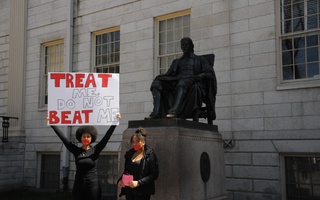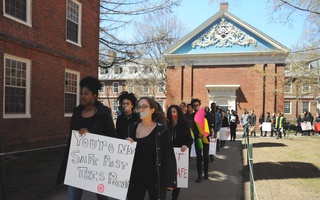In light of the physical police altercation on April 13 between a black undergraduate who was likely under the influence of narcotics and officers from the Cambridge Police Department, Harvard affiliates have raised important questions about College policies to protect and assist students. One of the primary concerns is exactly how the College’s amnesty policy for drug and alcohol use might apply in this case. Consequently, we call on the administration to explain when the amnesty policy applies to students and more clearly delineate policy for how the Harvard University Police Department and Harvard University Health Services intervene in such cases.
According to HUPD spokesperson Stephen G. Catalano, HUHS was contacted about the student. HUHS subsequently contacted HUPD, who in turn transferred the call to CPD, who he said had “primary jurisdiction.”
The College’s amnesty policy states that students seeking medical treatment for alcohol or drug-related illnesses for themselves or a friend will not face disciplinary actions for any illegal substance use in their interaction with HUHS or HUPD. Although the administration has given no indication that it will discipline the student involved in the police altercation, the event raises important questions about when the amnesty policy applies. Does the policy, for example, apply when police officers from the CPD or the Boston Police Department interact with students? Additionally, we question whether it was necessary to involve CPD in this case, and hope to see the administration set clear guidelines to determine when analogous situations cease to be medical emergencies and instead become matters involving law enforcement.
Last Saturday, Black Students Organizing for Change, a group formed by students in the aftermath of the traumatic incident, held protests and, through an open letter to the “Harvard Community,” presented a number of demands to the University, which merit consideration.
We support BSOC’s demand that Harvard acquire its own University ambulance. Harvard should seek to follow the example set by MIT, whose ambulance service is operated by a student-led Emergency Medical Services team. Acquiring a University ambulance will be an important step to ensuring that students who need medical help receive it safely, expeditiously, and, when possible, internally.
We also support the group’s demand for the establishment of an internal crisis response team, which would pursue short-term strategies to deal with medical emergencies and housing issues. Up until institutional changes aimed at preventing similar incidents are put into effect, the crisis response team would work to ensure safety and security for Harvard affiliates.
BSOC’s claim that HUHS dispatchers and HUPD officers should receive trainings regarding mental health is similarly valuable, as these trainings may well have altered the course of events in this incident.
In endorsing these three demands, we recognize that our suggestions are not exhaustive. We strongly encourage the College to listen to, consider, and respond to the other changes BSOC and other students, especially those who are disproportionately affected by the event, have proposed.
Ultimately, we hope that the administration clarifies its procedure for involving police in situations where students and affiliates require medical attention. If there is no existing policy, the administration must work quickly and effectively to create one in order to ensure that students remain safe. No incident like that of April 13 should ever happen again.
This staff editorial solely represents the majority view of The Crimson Editorial Board. It is the product of discussions at regular Editorial Board meetings. In order to ensure the impartiality of our journalism, Crimson editors who choose to opine and vote at these meetings are not involved in the reporting of articles on similar topics.
Read more in Opinion
Our Space, Our Voice: Welcome from Act on a DreamRecommended Articles
-
 Harvard General Counsel ‘Involved’ in Examining Student’s Arrest, Davis Says
Harvard General Counsel ‘Involved’ in Examining Student’s Arrest, Davis Says -
 After Arrest, UC Members Criticize Harvard’s ‘Failure’ to Keep Students Safe
After Arrest, UC Members Criticize Harvard’s ‘Failure’ to Keep Students Safe -
 Police, Health Services Obeyed Protocol in Arrest, Per Spokespeople
Police, Health Services Obeyed Protocol in Arrest, Per Spokespeople -
 'Treat Me, Don't Beat Me'
'Treat Me, Don't Beat Me' -
 Hundreds of Harvard Affiliates Sign Letter Demanding Reform After Black Student's Arrest
Hundreds of Harvard Affiliates Sign Letter Demanding Reform After Black Student's Arrest













